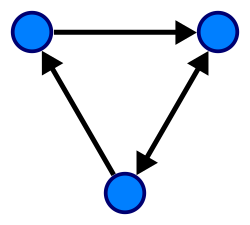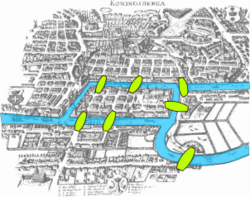Graph theory Graph theory is a field of mathematics about graphs. A graph is an abstract representation of: a number of points that are connected by lines. Each point is usually called a vertex (more than one are called vertices), and the lines are called edges. Graphs are a tool for modelling relationships. They are used to find answers to a number of problems. Some of these questions are:
Different kinds of graphs
HistoryA visualization of the Seven Bridges of Königberg. Leonhard Euler solved this problem in 1736, which led to the development of topology, and modern graph theory. A graph is an abstract data structure. It holds nodes that are usually related to each other. A node is a dataset, typically in the form of ordered pairs. Nodes are either connected or not connected to another node. The relation between nodes is usually defined as an Edge. Graphs are useful for their ability to associate nodes with other nodes. There are a few representations of Graphs in practice.   Leonhard Euler used to live in a town called Königsberg. (Its name changed to Kaliningrad in 1946). The town is on the river Pregel. There is an island in the river. There are some bridges across the river. Euler wanted to walk around and use each of the bridges once. He asked if he could do this. In 1736, he published a scientific article where he showed that this was not possible. Today, this problem is known as the Seven Bridges of Königsberg. The article is seen as the first paper in the history of graph theory.[1] This article, as well as the one written by Vandermonde on the knight problem, carried on with the analysis situs initiated by Leibniz. Euler's formula was about the number of edges, vertices, and faces of a convex polyhedron was studied and generalized by Cauchy[2] and L'Huillier,[3] and is at the origin of topology. The fusion of the ideas coming from mathematics with those coming from chemistry is at the origin of a part of the standard terminology of graph theory. In particular, the term "graph" was introduced by Sylvester in an article published in 1878 in Nature.[4] One of the most famous and productive problems of graph theory is the four color problem: "Is it true that any map drawn in the plane may have its regions colored with four colors, in such a way that any two regions having a common border have different colors?" Graph theory in perspectiveGraph theory is an important part of mathematics and computer science. To many such problems, exact solutions do exist. Many times however, they are very hard to calculate. Therefore, very often, approximations are used. There are two kinds of such approximations, Monte-Carlo algorithms and Las-Vegas algorithms. References
Related pages |














